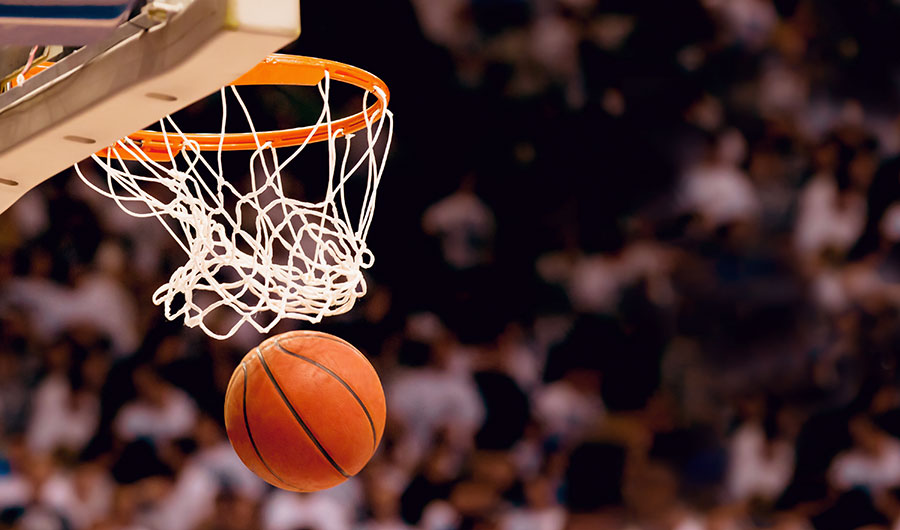The Subtle Biases That Influence Home-Court Advantage

Image credits: Brocreative/Shutterstock
(Inside Science) -- The NBA season tips off this week, and home-court advantage could play a big role in determining who advances in the playoffs and eventually claims the championship. But how much of an edge does the home team actually get?
According to a 2017 analysis from FiveThirtyEight, home teams win 64.5% of playoff games -- an increase from an already heightened 59.9% rate during the regular season. The apparent advantage could be even bigger in college basketball. During the 2017-2018 season most Division I men's basketball teams won more than two of every three home games.
Researchers have proposed and studied plenty of hypotheses for why home teams do better: a raucous crowd, less travel fatigue, familiar surroundings, biased referees, and even altitude.
“Some teams perform differently at home than away,” said Peter Chow-White, a communications scholar and big data analytics expert at Simon Fraser University in Vancouver, Canada. “But what the nature of that is, we’re not sure.”
Now, two recent studies are closing in on some answers. The first found that 2-pointers and free throws are key for giving the home team a boost, possibly due to subtly biased refereeing. The second study further supports the biased referee hypothesis, and also attributes home-court advantage to skewed scorekeeping. While neither group claims that their research is definitive, their work reveals more insight into why, for many teams, there's no place like home.
More basketball stories from Inside Science
Resting Healthy NBA Players During the Season May Not Help Them in Playoffs
The Science of Sneakers: High-Tops vs. Low-Tops
Artificial Intelligence in NBA Basketball
Running afoul
Equally matched home and away teams should, on average, take and make roughly the same number of 2-pointers and 3-pointers, and get fouled at about the same rate. But researchers from the University of Wisconsin-Milwaukee, found a curious discrepancy. Home teams tend to make more 2-pointers and free throws.
"Shot type is something that hasn't been looked at before," said Austin Harris, an atmospheric scientist and graduate student who co-authored the study with atmospheric scientist Paul Roebber.
They speculate that this pattern could be related to referees calling more fouls on visiting teams. Because 2-pointers happen closer to the hoop, tend to be contested more, and include aggressive drives for dunks and layups, they could be more susceptible to fouls. If referees were to call slightly more fouls against the visitor, then the home team has an advantage. Not only would the visiting team receive fewer fouls and free throws, but more of their 2-point attempts -- on which they were fouled but didn’t get the call -- would miss. On average, the researchers found, NBA home teams take 1.3 more free-throw attempts per game. Overall, the home team scores 3.24 more points per game, so the extra free throws account for almost a third of the difference.
To be clear, they don't have evidence referee bias is causing the difference in 2-point shots and free throws, Harris said. It's just one possible explanation for the discrepancy in shots between home and away teams, which itself may be just one aspect of home-court advantage.
Any referee bias isn't necessarily intentional either, Harris said. “It may not be a conscious thing.” Referees must make high-stakes, snap decisions under pressure; calling fouls can be subjective and human error is inevitable. Studies in football, soccer and basketball have suggested that crowds can influence referees, who according to one analysis might also subconsciously want to please the fans and the players.
The new study might also explain another pattern: the decline of home-court advantage in the NBA. Previous studies have shown that the benefit of home has steadily fallen since the mid-1990s. Not only did Harris and Roebber confirm this trend, but they also found that it coincides with a leaguewide drop in 2-pointers and free throws, and a rise in 3-pointers -- a profound shift that’s epitomized today by long-range shooters like Stephen Curry of the Golden State Warriors. If 2-pointers and free throws are the main manifestations of home-court advantage, Harris said, then this change in the style of play may be reducing the advantage of home court.
The analysis, published in July in the journal PLOS One, is based on team statistics from 32 NBA seasons. Harris and Roebber used a type of artificial intelligence called a neural network to look for the factors that correlate most strongly with the difference between a team's win percentage at home and away. Shots made -- free throws, 2-pointers and 3-pointers -- came out on top.
"The interesting thing they actually captured was changes in the structure of the game itself," Chow-White said.
Biased scorekeeping
Chow-White's own study found evidence for referee bias, showing that referees favored the home team more when the crowd was larger. Instead of the NBA, however, he and a team of researchers looked at college basketball, analyzing box scores of 100,000 men's and women's games spanning the three divisions of the NCAA. The researchers, who include Luke Bornn, of Simon Fraser University and the vice president of strategy and analytics for the Sacramento Kings, posted their paper online last month.
“The results are generally complementary to our study,” Harris said.
Home teams had better box scores overall, they found, and the most pronounced discrepancies were for the most subjective statistics -- blocks and assists -- which points at bias in scorekeeping.
Scorekeepers sit on the sideline, tabulating every event and stat. In the NCAA and the NBA, they are paid by the home team. Like a referee, scorekeepers must make rapid, often subjective decisions. A pass to an open teammate who immediately sinks a jumper is a clear-cut assist, for example. But if that teammate took a few dribbles to elude a defender before shooting, whether the pass is recorded as an assist depends on the scorekeeper's judgment and potential bias -- conscious or not.
Most notable, Chow-White said, was that these home-court biases were strongest for men's teams and Division I teams. The reasons could be due to differences in how scorekeepers are trained and paid among the different divisions and men's and women's leagues, all of which vary widely in resources. But human decision-making is complex, he said, and it's hard to know for sure why these discrepancies exist.
"We found what was there," Chow-White said. "But if you want to find why it's there, that's a much more complex question that's really difficult to infer from a box score."
Indeed, although the two studies may implicate referees and scorekeepers as potential causes of home-court advantage, other factors such as travel fatigue probably also matter. The root of home-court advantage is multifaceted, involving the physiological and the psychological. It's part of the complexity that keeps the outcome of a game in doubt, which is why basketball fans everywhere can't wait to watch.

